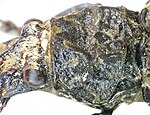Platyrhinus resinosus
| Platyrhinus resinosus | ||||||||||||
|---|---|---|---|---|---|---|---|---|---|---|---|---|

Platyrhinus resinosus (large weevil) |
||||||||||||
| Systematics | ||||||||||||
|
||||||||||||
| Scientific name | ||||||||||||
| Platyrhinus resinosus | ||||||||||||
| ( Scopoli , 1763) |
Platyrhinus resinosus is a beetle from the family of anthribidae that the superfamily is one of weevil-like. As a common name is frequently Big anthribidae used this name but also for similar bugs Platystomos albinus used. The two beetles are the easiest to the length of the sensor distinguishable at the Platyrhinus resinosus the trailing edge of the throat plate not clearly achieved while the smaller Platystomus albinus surmounted by far the trailing edge of the throat plate.
The genus Platyrhinus is only represented in Europe with the species resinosus . As synonyms to resinosus be costirostris , flavifrons , latirostris and oblongus called. Platyrhinus was also spelled in the form Platyrrhinus at times .
The genus name Platyrhinus is from Altgr. πλατύς "platýs" for "broad" and ῥίς "rhis, rhinós" for "trunk" and refers to the flattened trunk. The species name resinōsus ( Latin ) means "resinous".
Characteristics of the beetle
With a length of eight to fifteen millimeters, the flattened cylindrical beetle (Fig. 1 - 3) is the largest Central European member of the common weevil family. The irregular hair in different earthy colors enhances the gnarled impression.
The head and trunk are densely lightly haired. The antennae are the same length in both sexes and only reach the middle of the pronotum.
The strongly flattened trunk is significantly shorter than wide at the base and only slightly widened to the front. Its front edge has been cut straight off, and strong upper jaws are visible in front of it (Fig. 4). The round, strongly protruding eyes sit on the side of the head below the broad and depressed forehead. Far in front of the eyes, on the side of the trunk, not visible from above, the antennae are deflected (Fig. 6). The eleven-part antennae are uniformly dark, not kneeled, and end in a three-part, loose club.
The flat and coarsely wrinkled pronotum is depressed at the top. The depression is delimited at the back by a distinctive, curved crossbar, which is interrupted in the middle and bends to the side to the front (Fig. 5). The pronotum is about as wide in front as the head, it widens towards the back and, at the level of the transverse ridge, almost reaches the width of the two elytra together. Behind the crossbar, it narrows again.
The wing covers are unevenly ribbed and flattened at the top. They are predominantly darkly patterned in different tones, so the beetle can hardly be made out on a natural surface. The tips of the elytra are light, as is the base of the elytra in front of the pronounced shoulders. In addition, the wing covers have thin, irregular, light transverse lines. The point stripes consist of coarse, irregular and loosely standing points and only form roughly straight lines. The third space between the rows of dots is raised like a rib and ends in a bump (Fig. 3). The label is very small.
The dark rails are double brightly curled. The tarsi are four-part. However, they appear tripartite because the second tarsal segment is deeply triangular and the third, bilobed tarsal segment is located in this segment (Fig. 7). The claws have a small tooth on the underside (in Fig. 2 at full resolution the pair of claws can be seen on the lower right).
biology
The sluggish beetle can be found most frequently in the summer months (July, August) on fungal beech stumps up to the subalpine vegetation zone . Its occurrence is linked to clearly defined conditions ( stenotop ). It is limited to deciduous forests, preferably with beeches . There you can find the species in sun-exposed locations, for example on the edges of forests or in parks. The animals can be found on tree stumps and wooden fathers that are particularly fungal with Ustulina vulgaris , often together with the other great weevil Platystomos albinus , and with the rare alpine buck . There are also reports of finds of alders , oaks , birches , ash trees , firs and spruces . In Sweden it is often found on the coal ball mushroom on burnt hardwood trunks. In the event of danger, the beetle will lie on its back and pretend to be dead for a while.
The larvae are counted among the rotten wood-eaters ( saproxylophag ). They develop in white rotten wood that is still hard or in mushrooms.
distribution
The species is found in almost all of Europe , North Africa and the Middle East .
literature
- Heinz joy , Karl Wilhelm Harde , Gustav Adolf Lohse (ed.): The beetles of Central Europe . tape 10 : Bruchidae – Curculionidae 1 . Goecke & Evers , Krefeld 1981, ISBN 3-87263-029-6 .
- Gustav Jäger (Ed.): CG Calwer’s Käferbuch . K. Thienemanns, Stuttgart 1876, 3rd edition
Individual evidence
- ↑ a b c Platyrhinus resinosus in Fauna Europaea. Retrieved February 9, 2012
- ↑ Platyrhinus in Fauna Europaea. Retrieved February 9, 2012
- ↑ Heinz Freude , Karl Wilhelm Harde , Gustav Adolf Lohse (ed.): Die Käfer Mitteleuropas . tape 10 : Bruchidae – Curculionidae 1 . Goecke & Evers , Krefeld 1981, ISBN 3-87263-029-6 .
- ↑ Sigmund Schenkling: Explanation of the scientific beetle names.
- ↑ a b Klaus Koch : The beetles of Central Europe . Ed .: Heinz Freude . tape 3 : ecology . Goecke & Evers, Krefeld 1992, ISBN 3-87263-042-3 .






